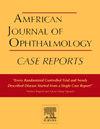高分辨率光学相干断层扫描在玻璃体黄斑界面病理学中的应用
Q3 Medicine
引用次数: 0
摘要
目的探讨高分辨率光学相干断层扫描(HR-OCT)与光谱域光学相干断层扫描(SD-OCT)在玻璃体黄斑病变中显微结构变化的诊断能力。方法对玻璃体黄斑界面病变进行前瞻性横断面研究。我们纳入了视网膜前膜(ERM)、黄斑裂孔(MH)、板层裂孔(LH)和玻璃体黄斑牵引(VMT)的患者。每位患者均接受全面眼科检查,随后进行SD-OCT和HR-OCT视网膜成像。分析图像是否存在关键生物标志物,并比较两种OCT模式。结果18例患者平均年龄66岁(SD 8.9),生理性别为男性(61.1%)。HR-OCT提供了优越的亚细胞视图,包括对核外层(ONL)和神经节细胞层(GCL)的棒细胞核的良好识别,以及增强的生物标志物的可视化,如“棉球征”和IZ中断(HR-OCT组和SD-OCT组分别为33.3%和5.6%,p = 0.0042)。在88.9%的HR-OCT病例中,ONL中的低反射点显示杆状细胞核,但在SD-OCT中完全检测不到(p < 0.0001)。年级间的信度很强,大多数生物标志物的Cohen's Kappa值在0.78到0.89之间。结论shr - oct可显著提高玻璃体黄斑界面病变的亚细胞特征和生物标志物的检测。该装置可提高玻璃体黄斑疾病的早期诊断和监测,与功能预后有潜在的相关性。本文章由计算机程序翻译,如有差异,请以英文原文为准。
High-resolution optical coherence tomography in pathology of the vitreomacular interface
Aim
This study investigates the diagnostic capabilities of high-resolution optical coherence tomography (HR-OCT) compared to spectral domain optical coherence tomography (SD-OCT) in detecting detailed microstructural changes in vitreomacular pathology.
Methods
This was a prospective cross-sectional study of eyes with vitreomacular interface disease. We included patients with epiretinal membrane (ERM), macular hole (MH), lamellar hole (LH), and vitreomacular traction (VMT). Each patient underwent a comprehensive ophthalmic exam followed by retinal imaging with both SD-OCT and HR-OCT. Images were analyzed for the presence of key biomarkers and the two OCT modalities were compared.
Results
The study cohort consisted of 18 patients with a mean age of 66 years (SD 8.9) and (61.1 %) had biological male sex. HR-OCT provided a superior subcellular view, including superior identification of rod cell nuclei in the outer nuclear layer (ONL) and ganglion cell layer (GCL) and enhanced visualization of biomarkers such as the “cotton ball sign” coupled with IZ disruption (33.3 % vs 5.6 % for HR-OCT and SD-OCT groups, respectively, p = 0.0042). Hyporeflective dots in the ONL, indicative of rod cell nuclei, were seen in 88.9 % of HR-OCT cases but were completely undetectable with SD-OCT (p < 0.0001). Inter-grader reliability was strong, with Cohen's Kappa values for most biomarkers ranging from 0.78 to 0.89.
Conclusions
HR-OCT significantly improves the detection of subcellular features and biomarkers in vitreomacular interface disorders. This device could enhance early diagnosis and monitoring of vitreomacular diseases, with potential correlations to functional outcomes.
求助全文
通过发布文献求助,成功后即可免费获取论文全文。
去求助
来源期刊

American Journal of Ophthalmology Case Reports
Medicine-Ophthalmology
CiteScore
2.40
自引率
0.00%
发文量
513
审稿时长
16 weeks
期刊介绍:
The American Journal of Ophthalmology Case Reports is a peer-reviewed, scientific publication that welcomes the submission of original, previously unpublished case report manuscripts directed to ophthalmologists and visual science specialists. The cases shall be challenging and stimulating but shall also be presented in an educational format to engage the readers as if they are working alongside with the caring clinician scientists to manage the patients. Submissions shall be clear, concise, and well-documented reports. Brief reports and case series submissions on specific themes are also very welcome.
 求助内容:
求助内容: 应助结果提醒方式:
应助结果提醒方式:


